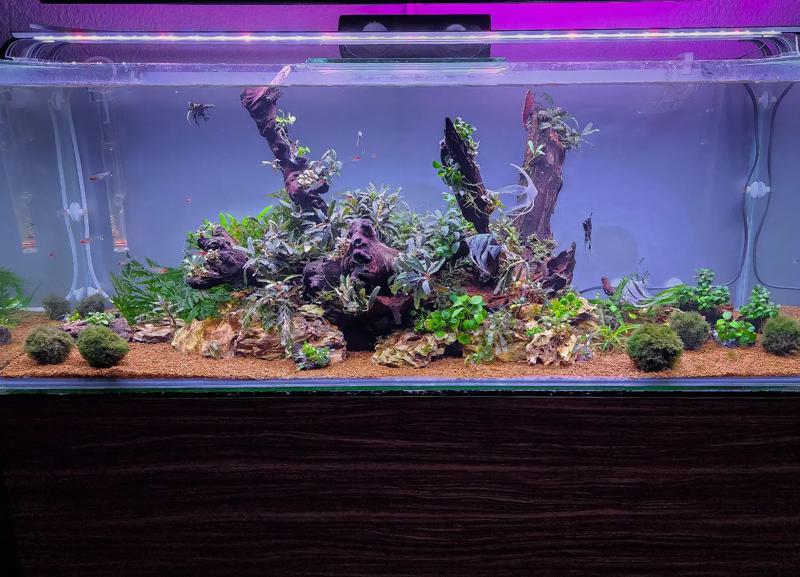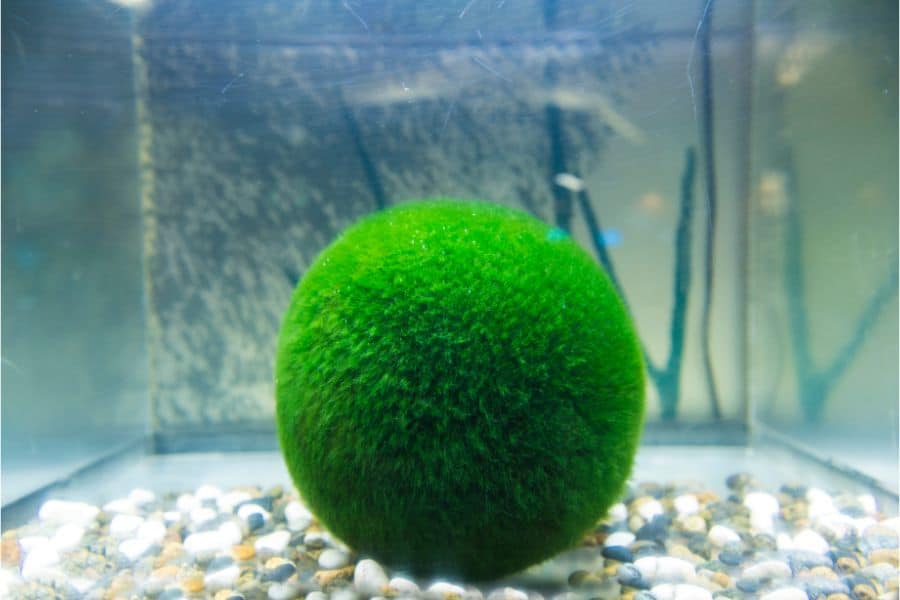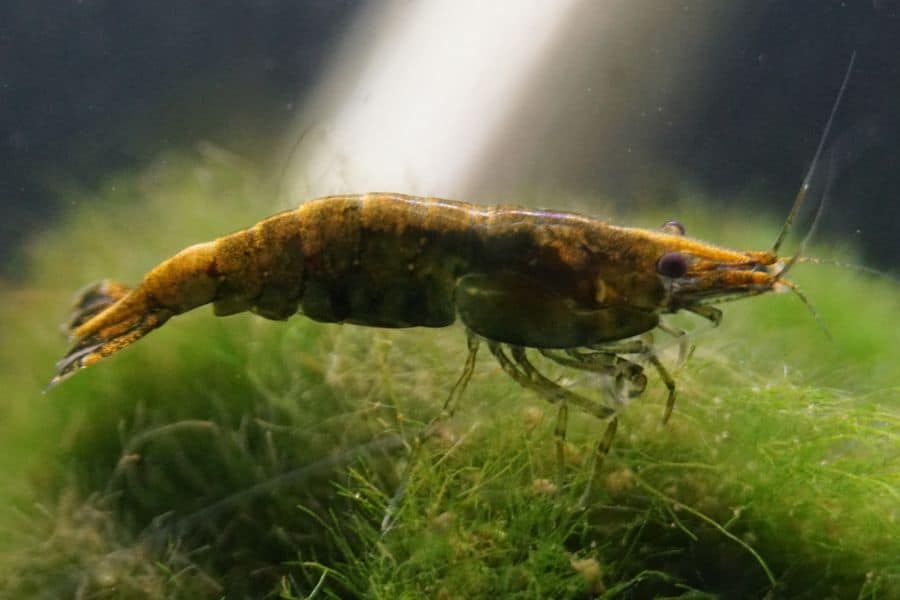Moss balls are often a great addition to one’s aquarium but don’t worry if you’re not familiar with them, as we’ll go over all there is to know about them in this article, including what they are exactly, their functionality, and how to care for them.
Marimo moss balls, though resembling moss, are a rare form of algae that naturally grows into a spherical shape over time and can add a splash of color to your tank and absorb nutrients that would otherwise go to other detrimental algae.
Routinely changing the water and keeping them in low light should be enough to care for them.
Before looking into caring for moss balls, let’s first dive into what they are exactly so that you’ll know why they’ll make a great addition to your tank and are worth keeping.
What Are Marimo Moss Balls?
Moss balls, also known as marimo, are a species of green algae (Aegagropila linnaei) that is native to Northern Europe and Japan but is commonly found across the world as a popular aquarium plant.
These green algae form into balls that can grow to roughly 2-5 inches in diameter within several years (their growth rate is typically about 5 mm a year). Moss balls can be found in many local pet stores and are purchased for home aquariums, mainly due to their ease of care and aesthetics.
The algae that form moss balls, unlike typical algae, don’t spread uncontrollably and instead only divide very gradually over time, making them safe to use without having to worry about them eventually overtaking the tank.
What Can Moss Balls Do?
Moss balls can be very beneficial to your tank, but their main function is to improve the aesthetics of your tank and to remove harmful nutrients in the water by absorbing them, hence limiting the growth of undesirable algae.
Removes Waste from The Water
Besides their appearance, moss balls can absorb detrimental toxins and pollutants that are produced by decaying matter in the water. Along with a typical filtration system, moss balls can help significantly reduce the amount of ammonia, phosphates, nitrates, and other waste in the water.
By removing toxic waste from the water, moss balls ensure that other harmful algae have no available food source, hence preventing their survival in the tank.
They Create Oxygen
Another function of moss balls is that they absorb carbon dioxide and release oxygen via photosynthesis (they are autotrophic algae after all). Though the amount of oxygen produced is not as much as what your typical air pump produces, it can nevertheless help in sustaining a healthy environment.
They Have Beneficial Bacteria to Break Down Toxins
Not only do the moss balls themselves act as a natural filter to toxins and debris, but they also contain many beneficial bacteria that continue the breakdown of these contaminants.
What Are Some Benefits of Keeping Moss Balls?
Besides the fact that moss balls can remove waste and oxygenate the water, there are several other benefits they can bring to your tank, the details of which we’ll look at now:
They Help Keep the Tank Clean
By acting as a natural filter, moss balls are able to keep your tank clean by removing all the harmful toxins and debris from the water (more than with a filter alone).
Since moss balls are also very dense and filled with vegetation, they are very efficient at their job while also requiring very little space in your tank.
As mentioned earlier, they also carry a lot of beneficial bacteria, which help break down ammonia into nitrites and eventually, nitrates, with each one being less harmful to your fish.
This way, moss balls keep the water quality at a very high level, which is much healthier for the fish, while also lessening some strain from the filter.
They Allow Fish to Breathe Easier
With them producing excess oxygen due to photosynthesis, moss balls allow your fish to breathe easier while reducing the strain on your air pump. If you have numerous moss balls in a relatively small tank, you may not need an air pump or air stone at all.
They Demand Little Care
Moss balls are very resilient to change and so, require little care from your part.
Since they filter water very efficiently, moss balls can tolerate decently unfiltered water and can also survive in a wide range of temperatures and pH levels. They also don’t require feeding, as they get their energy from photosynthesis.
Moss Balls Present No Harm to The Tank
Unlike various other plants, moss balls carry no parasites, small insects, or larvae. Therefore, they are very safe for your aquarium and possess a very low risk of contamination once they’re introduced to the tank.
Less Hassle Planting Them
Because moss balls are floating plants (mechanisms we’ll look at later), you don’t have to worry about tying them to an object or planting them on the substrate. This makes them really easy to introduce to your tank.
Moss Balls Prevent Algae Buildup
Not only do moss balls not spread to other areas of the tank, they also prevent the buildup of additional forms of algae by consuming their food supply, thus preventing the potential loss of fish and other animals in the tank.
Moss Balls Require Little Maintenance
As you’ll see later, moss balls require almost no maintenance throughout their lifetime, saving you lots of time and trouble. Moss balls grow very slowly, require little light, and don’t need fertilizer.
Tank Inhabitants Enjoy Them
Not only do people enjoy the greenery moss balls add to fish tanks, but the other aquarium inhabitants do as well. Fish sometimes play with them by pushing them around, and the fact that they gather a lot of uneaten food means that they are often ideal places for fish and other animals to scavenge for food.
You Don’t Have to Worry About Snails
If you happen to keep snails in your tank, you may be aware that they can often nibble on plants. For some reason, however, moss balls seem to be impervious to snails, thus you can rest assured knowing the plants will be safe from these tiny predators.
How Long Do Moss Balls Live?

Moss balls can live for an exceptionally long time, with some recorded living past 100 years.
Of course, this depends on the environmental conditions, how well you’re caring for it, and the size of the balls themselves.
In fact, some Japanese families keep them as family heirlooms that are passed down from one generation to the next due to their extreme longevity.
How to Care for Moss Balls
Caring for moss balls is pretty straightforward and simple since they mostly require very little maintenance. However, there are some tips you can follow to ensure they stay healthy.
Preparing your Aquarium
Moss balls can thrive in just about any type of container, not just an aquarium. However, do keep in mind that they should be kept away from direct lighting since they can develop brown spots that way.
You may also add a slight bit of freshwater aquarium salt to the water to keep them vibrant.
Planting your Moss Ball(s)
Simply drop your moss ball(s) in the water, as they don’t require a substrate or any hard object for them to attach onto.
Caring for your Moss Ball(s)
Routine water changes may be performed to replenish nutrients and prevent too much waste buildup.
The water temperature should also be kept on the colder side (less than 82 degrees Fahrenheit) as the moss balls may develop brown spots otherwise.
You don’t need to worry about feeding your moss balls or giving them fertilizer since they make their own energy source via photosynthesis.
Moss balls also go well with other live plants, so don’t worry if you’d like to place several different aquarium plants together.
One thing to keep in mind is that moss balls can cause other types of algae to grow on them. If you happen to have other fish in the aquarium (which I’m sure you do), they can usually eat the excess algae off the ball.
If you don’t have fish to consume the excess algae, you may consider giving the moss balls a bath. To do this, you may place them in a small container with clean, dechlorinated water and slowly roll and squeeze them until the gunk is gone.
During the bath, you may also gently roll the moss balls in your cupped hands to turn them back into their spherical shape if they seem to have lost their shape.
If your moss balls happen to live on their own, you might wish to replace half the water every few weeks in order to retain a clean habitat. You can reduce these water changes if they share the aquarium with other inhabitants.
Propagating the Moss Ball(s)
Depending on the moss ball(s), they can either break off on their own and form a new ball (asexual reproduction via budding), or you can propagate them yourself. After choosing a mature plant, remove it from the tank, squeeze out any excess water, and cut the ball in half using a knife or scissors.
You can then roll each half until you have two spheres, which you can wrap in strings to retain their shape. The new spheres will then continue growing on their own (be sure to turn them every week or so in order for them to retain their color and spherical shape).
Also Read:
FAQs
1. How Do Moss Balls Interact with Betta Fish?
Moss balls and betta fish often live well together. As previously mentioned, one benefit of moss balls is how well they go with many other tank inhabitants, and betta fish are no exception.
Bettas especially enjoy resting on and playing with moss balls; one may often find the fish rolling them around like soccer balls. Other betta tank mates, such as ghost shrimp and snails, also enjoy moss balls due to their tendency to harbor small particles of food.
Moss balls can also live in the same water conditions as betta fish (though they can grow faster in colder temperatures).
2. Do Moss Balls Grow?
Moss balls do indeed grow.
As mentioned earlier, moss balls grow very slowly at about a rate of 5 mm per year. They have been observed growing up to 2-5 inches in diameter in captivity, and up to 8-12 inches in the wild.
3. Why Do Some Moss Balls Float?
Moss balls float due to the presence of air bubbles/pockets inside them. Simply squeeze them gently to remove the air bubbles/pockets and allow them to sink.
Moss balls have also been observed floating during the day and sinking by night, a phenomenon caused by a combination of photosynthesis and circadian rhythms (details on this study can be found here).
Conclusion
Marimo moss balls are a popular aquarium plant that is known for its ease of care. Simply follow the guide we’ve discussed here, and you should have no problem tending to them and making the rest of your tank inhabitants happy along the way.

